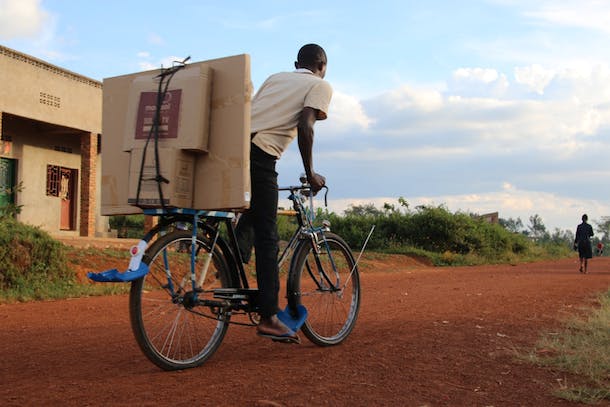
Editor’s Note: This post originally appeared on the Energy Access Practitioner Network website.
We spoke with Thomas Duveau, Head of Business Development at Mobisol, to discuss the company’s work in combining solar energy with payment plans via mobile phone, comprehensive customer service, and innovative remote monitoring technology. Interview edited for length.
Can you tell us a little about Mobisol and its history? When was it created, and why?
The founder of Mobisol, Thomas Gottschalk, traveled the world in 2008 and returned home with a question – if Germany, with all its rain, can be powered with solar energy, why can’t we do the same for Africa?
As we considered the possibilities, we discovered three potential barriers. First, there’s a potential financial barrier: This system costs hundreds of dollars, so we needed to develop a pre-financing loan to finance the system for the customer who will repay over installments.
The second barrier to entry involves communication: We need to be able to communicate with the system to make sure it’s working. We solved this issue with a SIM card embedded in every system. Every system sends a complete technical report to the database every 10 minutes. We’re a very data-rich company, which we use for preventive maintenance in real-time, and to develop the system to tailor it for the customer’s real needs.
The third barrier to entry is service: We learned from the experience of people who have bought no-name systems on the market, and then have no one to turn to when the system stops working; it’s useless, it’s dead.
In Swahili, there is no exact word for “guarantee,” and the concept of somebody fixing your system immediately is not found often in rural areas. Mobisol provides a service guarantee for the three-year duration of the loan, a 1-800 number, and a 48-hour guarantee to resolve any issue. People know that we will come; they’ve come to expect it. You’ll never succeed in the market of rural areas if you don’t guarantee quality. If you don’t give them what you promise, they would call us out on it.
What have you learned over the years?
It’s important to respect your customer. If your customers say they need something, we respect that. Our customers have shown that when it comes to energy, big is beautiful, and we work to support that. Real electrification is more than three lights. We want to become a substitute for infrastructure, and to do that, you need to provide exactly what the infrastructure would. There is a paradigm shift: Electrification with large solar home systems (60 Watt and more) is increasingly seen as part of the solution to the electrification challenge in rural areas.
What sets Mobisol apart? What is your innovation?
Part of our innovation lies in our finance: We call it “rent-to-own.” Customers pay 36 installments over three years, after which they own the system, and this is a very important distinction, the ownership of the system. This is probably the largest investment these people have ever made besides their home and their motorcycle. They want to own it. Our customers love to be owners of this system. Out of 20,000 systems in the field, only two were ever stolen. Why? Because people take care of their systems, because they own it. If you don’t own your system, you won’t take care of it. Ownership is a prerequisite for scale. And they’re proud, because they have ownership. Philosophically, that is key for us.
Also, we provide the complete electricity needs for customers and give them access to productive use. Mobisol provides real infrastructure, more than one small solar system. Our customers aren’t constrained; it’s their choice to use the energy as they like. The amount we can provide to them is enough to allow them to use the appliances that they want.
What areas and nexus issues of energy access do you work on?
The Mobisol system is really having an impact on local entrepreneurship. I was speaking to one of our entrepreneurs who uses the electrification system to charge phones for others in the village. When I called the Mobisol system a “solar home system,” he said, “That’s not what you’re selling.”
I told him, “Yes it is, my friend, it’s a solar home system.” “No,” he replied, “you’re not selling solar home systems, you’re selling money-making machines. Your system is generating incremental income for me. We’re generating more money with these systems than I am paying.”
Forty percent of our customers earn money with Mobisol systems – they charge cell phones, they charge solar lanterns.
Also, by replacing kerosene lamps with solar energy, you get rid of fossil fuels. This doesn’t just improve climate change — the quality of the air in the house is better. Kids who study with a clean solar light study better, tapping into their full educational potential. Rwanda has the One Laptop Per Child project – which has committed to provide every child in Rwanda with a laptop. The problem is, 90% of these kids don’t have electricity at home, so we developed charging stations in the schools. Now, the kids can plug their laptop in to charge during the day at school, and then take their laptop home to work on for several hours at night.
We also electrify small village clinics, powering refrigerators for cooling of medication, lighting the clinics at night, and powering equipment. At one of the clinics Mobisol brought power to, two women gave birth on the first night our system was installed, and it was the first time anyone had performed a delivery at night under light.
How does Mobisol’s work fit within Sustainable Energy for All (SE4All)?
SE4ALL has the goal of doubling the share of renewable energy by 2030. It’s a great goal, but it’s not ambitious. Mobisol is working much faster than this. We’re looking beyond doubling the rate of renewables by 2030 – currently, Mobisol doubles every eight months. We’re helping SE4ALL by pushing that goal beyond its targets. It’s not a stretch target at all.
What is 2030 in Africa? It’s too far away. People aren’t planning for 2030, they’re planning for now, and they want fast results. Mobisol systems produce results here and now. The Mobisol system is set up in one hour. Two nails to put it on the roof, and it’s installed.
How does Mobisol measure success?
Our solar systems are in 20,000 households – that’s 112,000 people impacted directly by the Mobisol solar home system. We’re also powering a few hundred schools, and clinics as well. We have 7,000 entrepreneurs who make money out of the Mobisol system, and these 7,000 are making about $10 million additional incremental income. People are getting jobs, and good jobs trained by Mobisol.
Also, we’re seeing environmental success – every Mobisol system saves the equivalent of half a ton of CO2 emissions every year. With 20,000 systems currently in use, Mobisol is replacing 10,000 tons of CO2 every year.
What challenges has Mobisol encountered over the years?
We’ve seen two challenges. The first is finding the right people on the ground and finding the employees who have the same dedication and will to sell, especially in management positions. Ultimately, we’re trying to find the staff to bring it out there. The other challenge is that the more successful we are, the more money we need. We need working capital loans, people who will believe the system, give us the money, and allow us to sell over time. We’re growing so fast that arranging the right financing is key. Capital at scale is key for us.
How has the UN Foundation and/or the Energy Access Practitioner Network helped your organization?
The Practitioner Network has been key, helping us to grow and build our network, and to increase our exposure.
What advice do you have to share from Mobisol’s experiences to help inform and educate other practitioners?
Take your customers seriously, don’t fool with your customer. Ask your clients what they want, and really listen to them. Develop your products to better serve them. Also, hold on to the belief that the solar revolution makes more sense than fossil fuels.
The doors of Mobisol are always open to Practitioner Network members to learn more about us, learn from our experiences, and to share your experiences and learnings with us!



 View All Blog Posts
View All Blog Posts